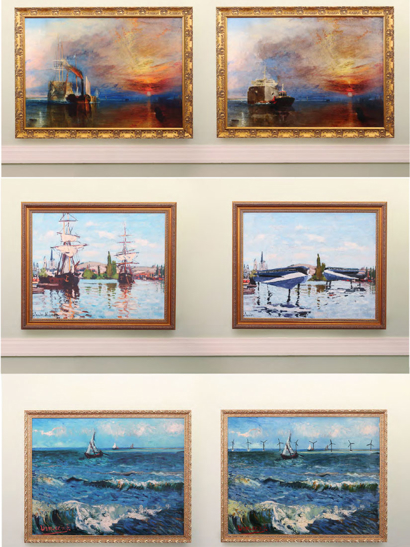The LR Maritime Decarbonisation Hub was officially launched with the opening of an interactive virtual gallery showcasing well-known artworks reimagined to depict a zero-carbon maritime future, shining a light on the need for ships with zero-carbon emissions to be on the high seas by 2030, along with the supporting infrastructure.
LR collaborated with renowned artist, Reuben Dangoor, to reimagine well known 17th and 18th century oil paintings, which were showcased alongside their originals at the event. The six-piece collection sees works of old masters, including the likes of JMW Turner, Vincent Van Gogh and Claude Monet, and all featuring ‘original’ zero-carbon sailing ships, recreated to depict carbon-neutral vessels of the future, emerging infrastructure and maritime technologies that will address shipping’s decarbonisation challenge.
Included in the collection is JMW Turner’s ‘The Fighting Temeraire’ from 1838. It’s one of his most-celebrated works, depicting the last voyage of the warship HMS Temeraire, as she is towed by a coal-powered tug down the Thames to be broken up for scrap. This final voyage is replicated in the reworked picture with a futuristic twist, as the decaying HMS Temeraire is replaced with a carbon-emitting tanker of today, towed by a tug powered by a hybrid energy source. The piece highlights LR’s intention to assist the maritime industry in the transformation of global fleets, forging safe, sustainable pathways to a zero-carbon maritime industry.
Each of the pieces, created digitally by Dangoor, is being showcased as part of a 360 degree virtual gallery tour, hosted at listed venue Carlton House Terrace and available for public view on The Maritime Decarbonisation Hub website. Whilst the works of art are clearly creative and future focused, they are also grounded in reality. LR’s Lead Marine Consultant Yildiz Williams worked closely with Dangoor on each of the artworks to ensure LR’s breadth of experience working on cutting edge decarbonisation technologies was woven into the project.
The gallery launch was preceded by a leadership webinar on shipping industry efforts in support of the energy transition. Moderated by Lloyd’s List’s Richard Meade, the panel discussed the commercial, technical and societal imperatives that are driving the industry towards decarbonisation, the impacts on maritime trade, the potential cost of inaction and what role the Hub will play as the pace of regulation increases.
Speaking at the webinar, President and Group Chief Executive Officer at MISC Berhad, Yee Yang Chien, said: “The energy transition is before us. We are all affected. As shipowners, we must act and this requires a practical approach. The Maritime Decarbonisation Hub is another example of how the shipping industry is really trying, and I am hopeful.”
Special Adviser, Ocean, to the UN Global Compact, Sturla Henriksen, commented on the drivers that will help shipping decarbonise: “Most instrumental is how business and markets are disciplining shipping. Financiers are rewarding those who are above regulatory standards, consumers are punishing those who are not transparent, paving the way for higher regulatory standards.” LR’s Marine and Offshore Marketing Director, Jeannie Ivanov led the campaign to launch the Decarbonisation Hub, said: “The Future Seascapes exhibition connects the commercial, technical and societal needs to accelerate shipping’s decarbonisation journey. The collaboration with Reuben Dangoor enables us to raise the profile of the importance of decarbonising shipping in mainstream society, helping people understand the critical role shipping plays in global trade and society more broadly.”

Who is Reuben Dangoor?
British artist Reuben Dangoor creates work heavily influenced by current affairs. When his portraits of Stormzy, Skepta, Dizzee Rascal and D Double E were unveiled in Tate Britain’s Legends of the Scene exhibit in 2015 he gained coverage around the globe as the first artist to bring the stars of the Grime movement into a British museum. In 2018, his portrait of Jeremy Corbyn ‘dabbing’ was shown in The Design Museum Art of Politics exhibition. In summer 2018, Reuben Dangoor had another huge viral moment when his line drawings of the England football squad were picked up online, in print and on TV. Reuben Dangoor’s viral piece of Gareth Southgate was bought by the Southgate family and now sits in the England manager’s home office. His 3-D billboard for the BBC’s hit Dracula series went viral around the world in January 2020.







